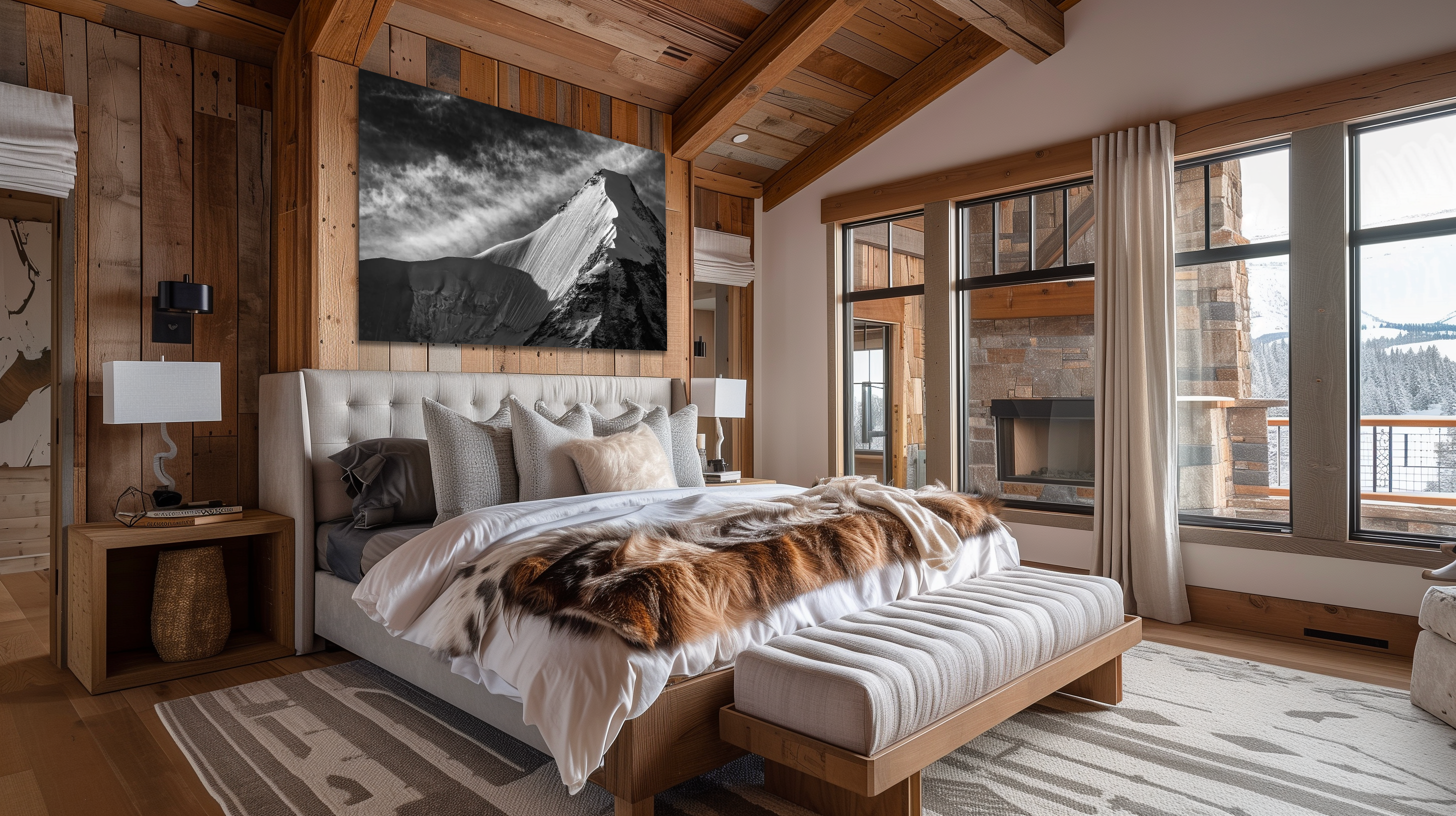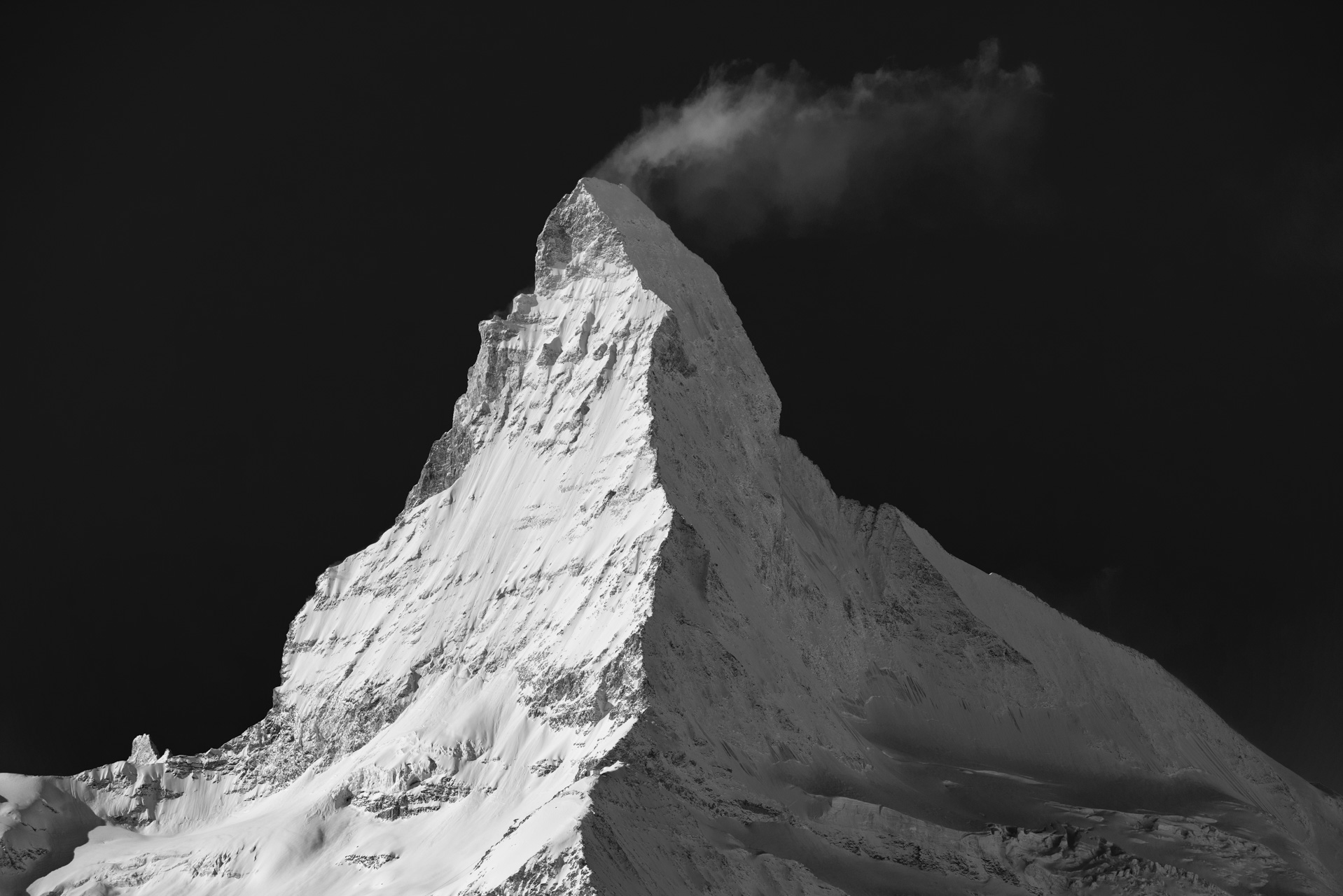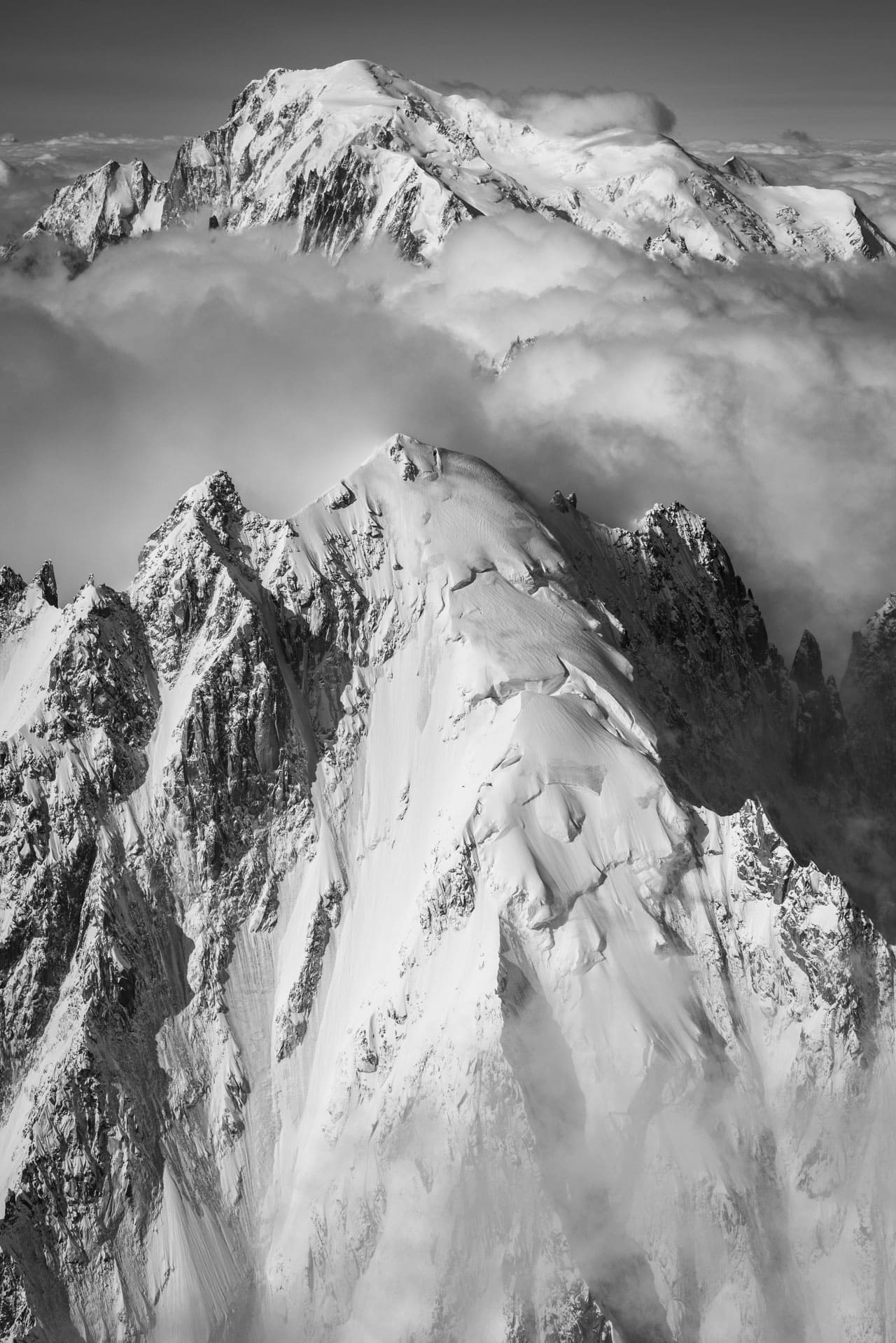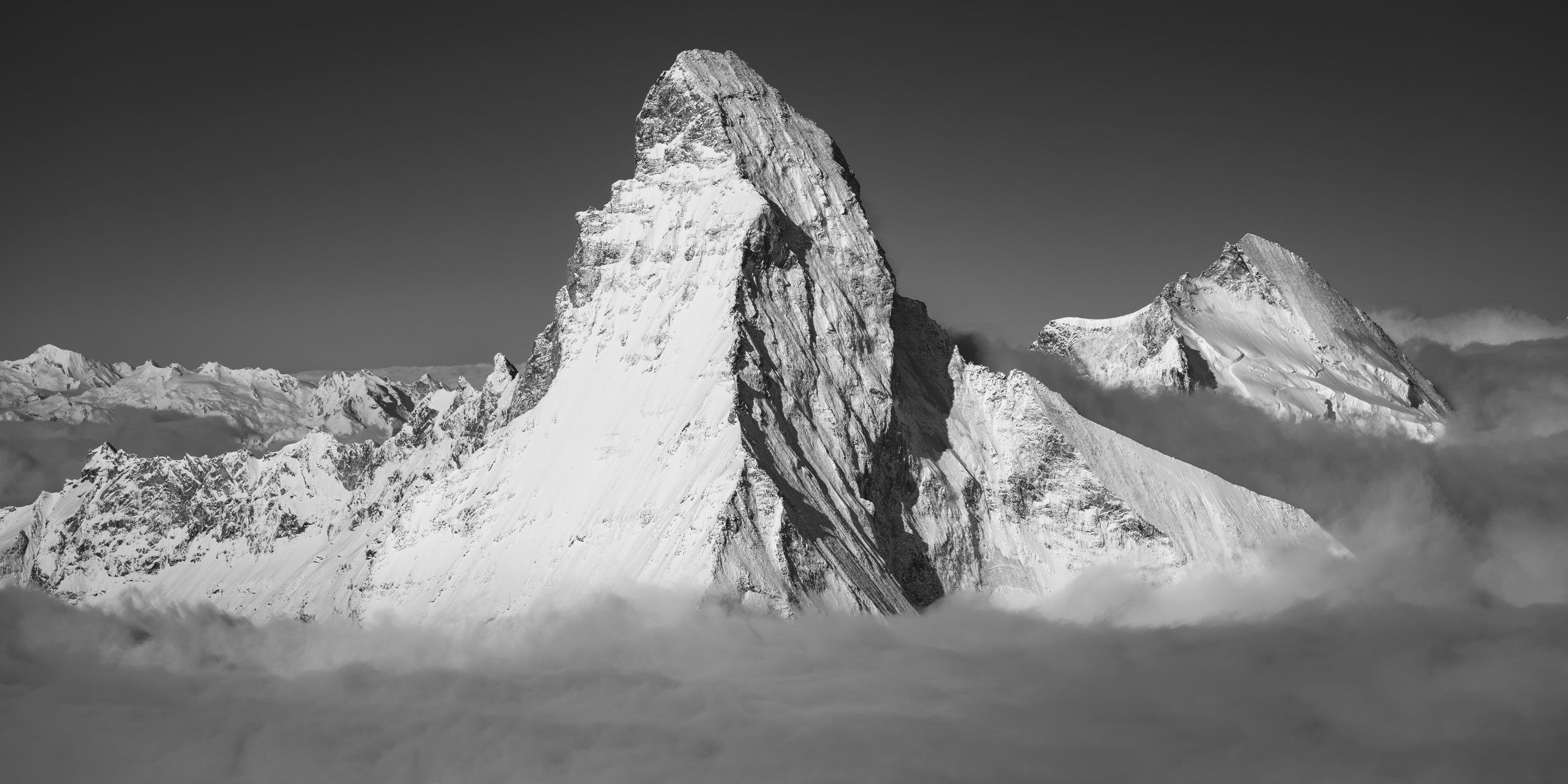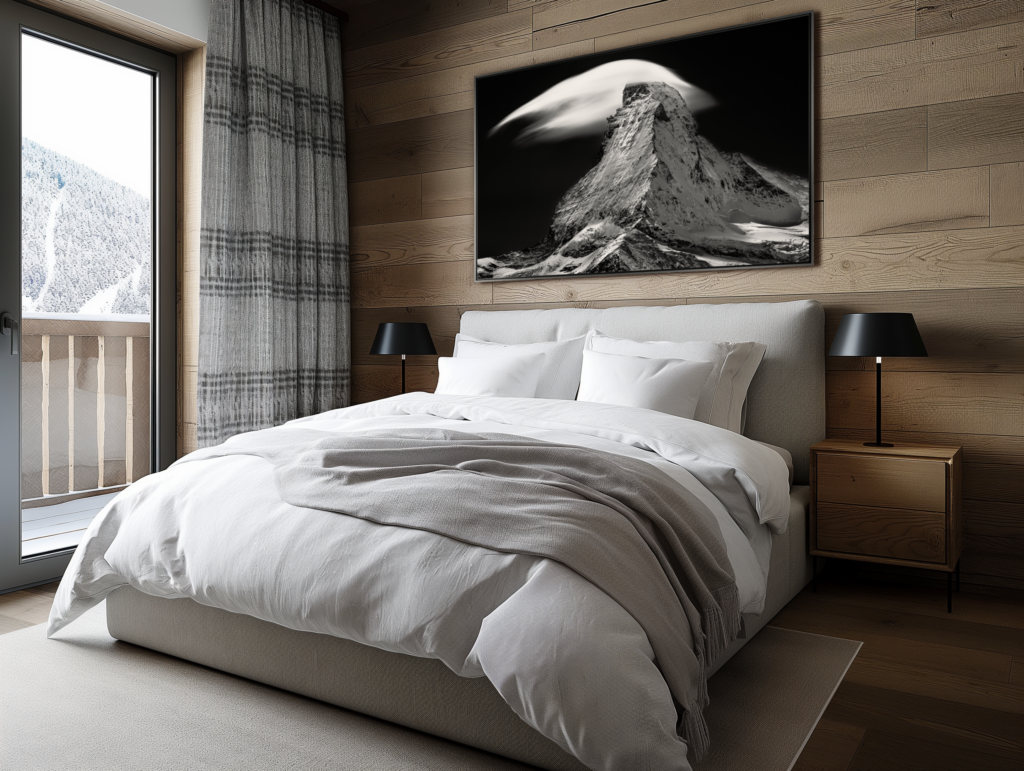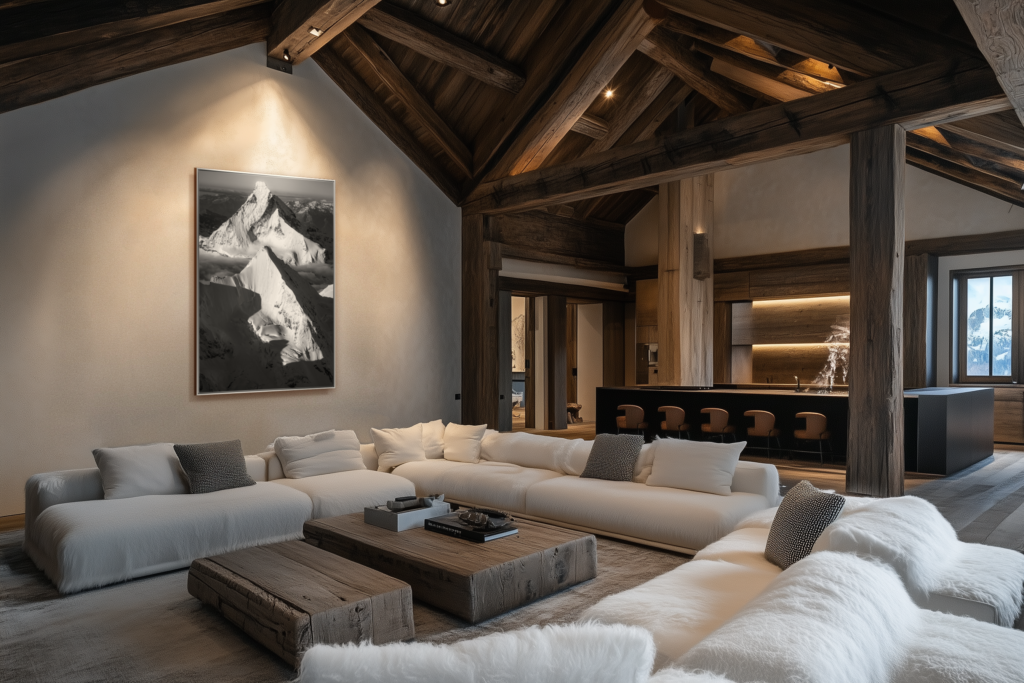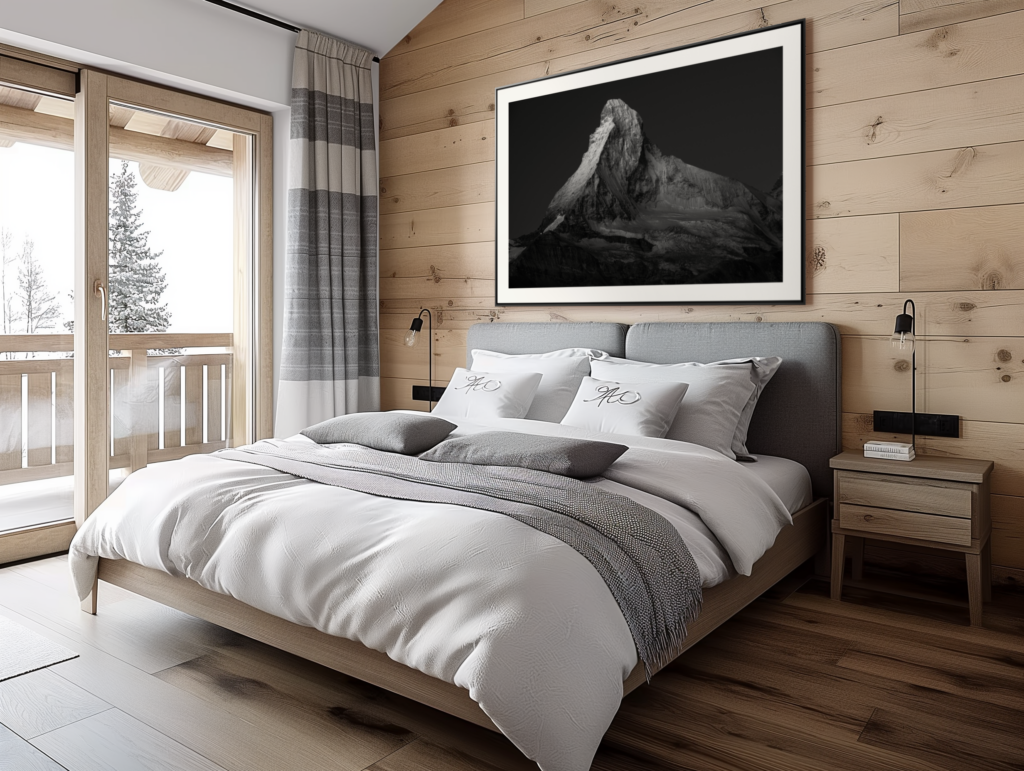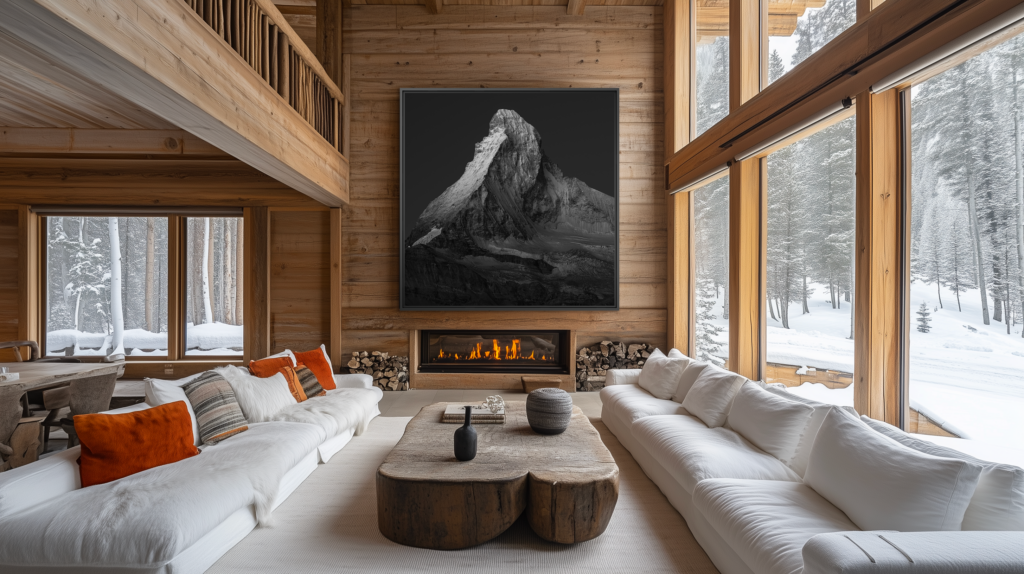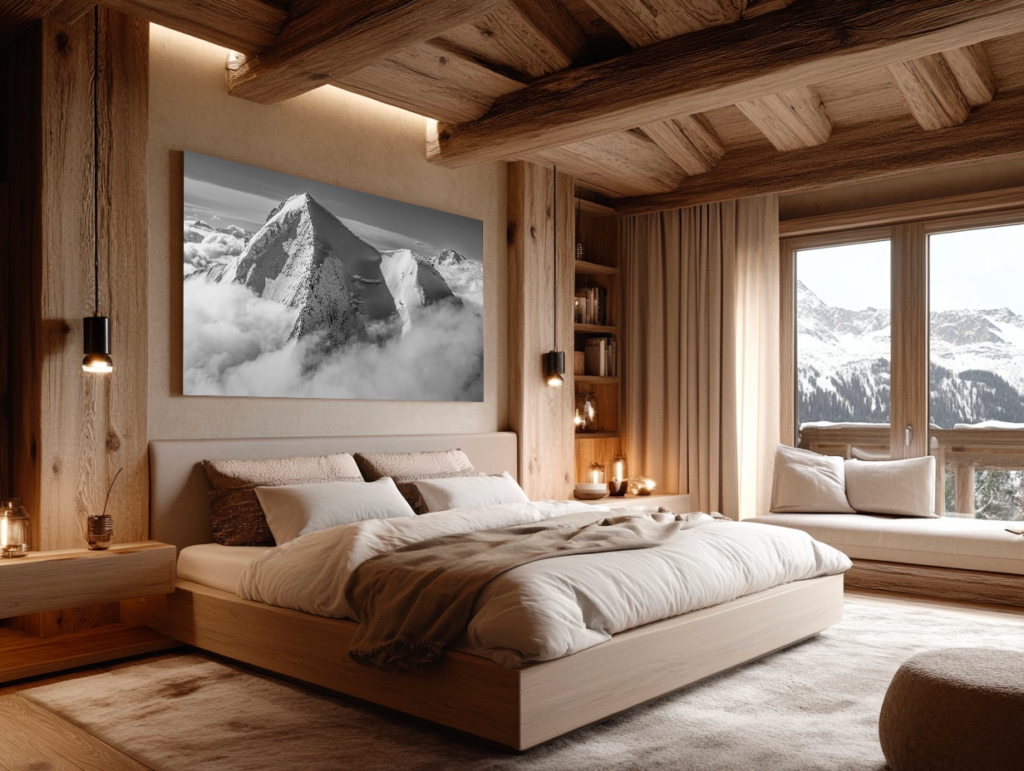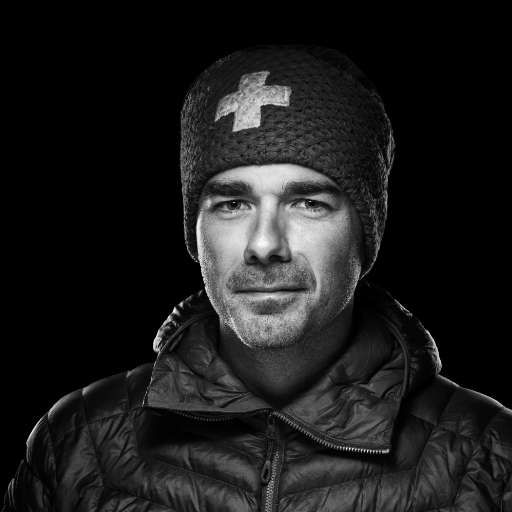In the exclusive world of prestigious Alpine chalets, art no longer simply adorns the walls - it embodies the soul of the place and reflects the sensibility of its owners. In 2025, we are witnessing an artistic renaissance in these high-altitude refuges, where each work of art becomes the fruit of a meeting between the majesty of the summits and the demand for uniqueness specific to a discerning clientele.
The owners of these exceptional homes are now looking for creations that transcend mere ornamentation. They prefer unique, custom-designed pieces that establish a subtle dialogue between the natural environment and their personal history. In this way, the chalet is transformed into a living jewel box, where each piece simultaneously recounts a fragment of the mountain and a piece of intimacy.
Here are the twenty major trends shaping the artistic landscape of today's exceptional alpine residences, reflecting a quest for authenticity, uniqueness and excellence.
1. Celebrating raw materials
Creations featuring the elements in their purest state - unpolished stone, gnarled wood, hand-forged metal - are enjoying an Previous popularity. Alpine artists integrate fragments of local rock or sections of age-old tree trunks into compositions where nature dictates.
This approach responds to a search radical authenticity. The cultured clientele of Fine Alpine Post understands that true sophistication sometimes lies in assumed simplicity, where the telluric force of the mountains is expressed without artifice. These works, often monumental, become the emotional anchor of the space, reminding us that contemporary luxury is perfectly suited to primitive ruggedness.
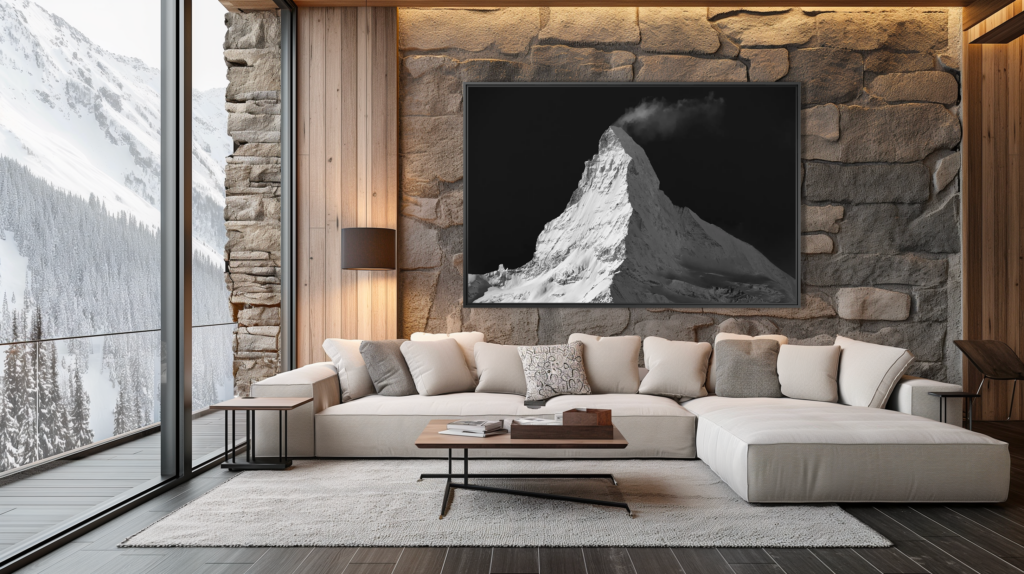
2. Custom panoramic frescoes
The vast murals are enjoying a spectacular revival, reinterpreted by contemporary artists. These masterful creations, often hand-painted directly on the interior walls, visually extend the panoramic views from the chalet's windows.
In the resort of Gstaad, a recent artistic achievement transposes the winter view from the terrace onto an entire wall, playing on variations in deep whites and blues. This pictorial immersion abolishes the boundary between inside and outside, creating the illusion of a permanent dialogue between inhabited space and alpine immensity.
3. Promoting regional craftsmanship
Connoisseurs are now incorporating pieces from local craft traditions into their homes, but reinterpreting them in a contemporary way. Savoyard pottery, Valais woodcarvings and textiles woven in high-altitude workshops are all elevated to the status of works of art.
Maison Allard in Megève recently collaborated with three local craftsmen to create a composite installation combining chased copper, carved arolle wood and glazed ceramics. This work, commissioned by a Swiss industrialist for his chalet on Mont d'Arbois, perfectly illustrates this trend towards local excellence magnified.
4. Monumental photography in prints
Alpine photography, once considered documentary, is now asserting itself as a major form of artistic expression. Large-format prints , numbered and signed, mounted on noble supports such as brushed aluminum or Dibond, are becoming collector's items.
Thomas Crauwelswith his uncluttered vision and mastery of black and white, now offers exceptional prints that capture the fleeting moment of golden light on a ridge, or the hypnotic movement of fog rolling down a valley. These works offer an almost architectural presence, transforming a wall into a window opening onto a moment of alpine eternity.
5. Blown glass evokes glacial transparency
Hand-blown, hand-sculpted or thermoformed glass works are inspired by the play of light in high altitude glaciers and frozen lakes. Master glassmakers play with mineral inclusions and variations in thickness to imitate the strata of millennia-old ice.
In Chamonix, the Cristallerie des Alpes studio creates unique pieces in which glass is worked in successive layers, sometimes mixed with bluish pigments or quartz flakes. Installed near windows, these sculptures capture natural light and diffuse it in changing shards, reproducing the sparkle of seracs under the sun.
6. Pictorial abstraction as an echo of telluric force
Far from literal representations, some collectors are turning to more abstract expressions, where the power of alpine elements is suggested rather than described. Some contemporary artists use casting, scraping or oxidation techniques to evoke erosion, landslides or the slow drift of glaciers.
These abstract works, often in large format, bring a contemporary dimension to traditional interiors. They create a striking counterpoint to the chalet's classic architectural elements, while establishing a subtle dialogue with the primordial forces that shape the Alpine landscape.
7. Wood sculpture tells personal stories
The age-old art of woodcarving is enjoying a renaissance with highly personalized creations. Local master carvers create bas-reliefs or rondes-bosses that incorporate biographical elements of the owners - the silhouette of their chalet, family emblems, references to their memorable ascents.
A recently completed home in Verbier features an impressive walnut wall panel depicting the story of four generations of a family, interwoven with the topography of the summits they climbed together. This narrative dimension lends the work an inestimable sentimental value, above and beyond its intrinsic aesthetic quality.
8. Minimalist graphics inspired by alpine lines
In chalets with contemporary architecture, works reduced to the essential are gaining in popularity. Radically simple compositions - a few strokes suggesting the profile of a mountain range, the angularity of a summit or the winding course of a stream - harmonize perfectly with uncluttered spaces.
These minimalist creations, often created in black ink on a Light background or engraved in metal, capture the very essence of the Alpine landscape. Their strength lies in their ability to capture, in a few precise lines, what makes up the unchanging identity of a place. This approach is particularly appealing to aesthetes initiated into Japanese art, where restraint becomes synonymous with depth.

9. Preserved botanical and mineral compositions
As part of a drive to conserve and celebrate Alpine biodiversity, glass compositions are enjoying a remarkable renaissance. Alpine artist-botanists are creating installations in which high-altitude flowers, mosses, lichens and minerals are meticulously assembled and then preserved under blown crystal cloches.
These works, halfway between a cabinet of curiosities and a contemporary installation, freeze a moment of Alpine nature in all its delicacy. Each composition can be made to order, immortalizing the specific flora that surrounds the property or constituting an artistic herbarium of the massif's emblematic plants.
10. Luminaire sculptures and light displays
The boundaries between art and functional design are blurring with the emergence of lighting fixtures conceived as veritable sculptures. These masterpieces, suspended in the generous volumes of contemporary chalets, often take the form of metallic constellations, intertwined branches or crystalline formations inspired by stalactites.
Light becomes an artistic material in its own right. Sophisticated lighting installations incorporate programmable LED systems that reproduce the subtle variations of natural light at altitude - from the pale pink of dawn on the glaciers to the deep blue of winter twilight. These works of light transform the interior atmosphere hour by hour, echoing the constant metamorphosis of the Alpine landscape.
11. Contemporary mosaics with topographical motifs
Traditionally confined to wet areas, mosaics have now moved into the main living areas. Specialized artists create monumental compositions on floors or walls, using natural stone, colored glass and sometimes precious metals to reproduce stylized cartographies or geological cross-sections.
A recent project in a chalet in Courchevel features a mosaic floor that recreates the path of a glacier from the air, with its moraines and crevasses. Made up of thousands of meticulously assembled tesserae, the work offers a visual and tactile experience that is renewed with every step.
12. Interactive installations and kinetic art
The integration of discreet technologies into seemingly traditional works of art now enables creations to react to their environment. Suspended mobiles in double-height spaces move imperceptibly in response to air currents, while more complex installations respond to variations in temperature or humidity.
For a chalet in Zermatt , an alpine innovation studio recently designed an artistic wall that translates weather data captured on the Matterhorn into real time, through variations in light and subtle movements. This fusion of technology and artistic sensibility creates a living, constantly evolving work that establishes a dialogue between the hushed interior and the extreme conditions of the high mountains.
13. Monumental art textiles
Contemporary tapestry is enjoying a remarkable renaissance in Alpine interiors. Textile artists from the Alpine regions are creating monumental pieces in which merino wool, silk threads and sometimes metallized fibers intermingle to form compositions inspired by mountain landscapes.
These textile works, often made on traditional looms but with a resolutely modern vision, bring warmth and hushed acoustics to the generous volumes of the chalets. Their tactile presence contrasts with the minerality of stone or the rigor of wood, introducing an additional sensory dimension to the experience of space.
14. Engraved marble and local stone
Stone engraving, heir to a long Alpine tradition, is being renewed through contemporary creations where poetic texts, precise cartographies or abstract motifs are chiseled into marble or local stones such as slate or gneiss.
Specialized workshops create wall panels with extraordinarily fine engravings of poems evoking the mountains or quotations dear to the owner's heart. These elegantly sober works of stone lend a timeless presence, often symbolically anchoring the chalet in its mineral surroundings.
15. Burnt wood, a blend of Japanese tradition and Alpine spirit
The ancestral Japanese technique of shou sugi ban (charred wood) finds a particular resonance in the Alpine context. Local craftsmen adapt it to create wall panels or installations in which the wood, burnt then sealed, evokes both the force of the elements and nature's resilience in the face of harsh climatic conditions.
This technique gives the wood a deep black hue and a singular texture, in striking dialogue with the lighter materials of the chalet. The almost fossilized appearance of these creations is reminiscent of the lightning-charred trunks sometimes found in the high mountains, silent witnesses to the power of the elements.
16. The fusion of advanced technology and traditional craftsmanship
The combination of digital modeling and traditional skills opens up fascinating new perspectives. Innovative art workshops use 3D printing to design complex shapes, which they then translate into noble, hand-worked materials - local wood, cast bronze, carved stone.
This hybridization of approaches results in works of unprecedented precision, such as this relief map of an entire massif, first digitally modeled from exact topographical data, then carved from a block of maple by local craftsmen. These works perfectly embody the encounter between heritage and innovation that characterizes the contemporary Alps.
17. Interdisciplinary collaborations between artists
Creations born of collaborations between artists from different disciplines appeal to customers in search of uniqueness. A photographer and a painter, a sculptor and a goldsmith, or a glassblower and a lighting designer can combine their talents to create exceptionally rich composite works.
A recently completed home in Gstaad features an installation in which monochrome alpine photographs, printed on glass panels, are placed in dialogue with pictorial interventions, creating a multi-layered work that reveals itself differently depending on angle and light.
18. Art hidden in functional elements
The integration of artistic expression into utilitarian chalet elements - sliding doors, bedheads, shower enclosures - responds to a search total harmony between function and aesthetics. Laser-engraved motifs, precious metal inlays and contemporary marquetry techniques transform these surfaces into works of art in their own right.
This discreet luxury, which only reveals itself to the attentive eye, characterizes a sophisticated approach where art permeates every detail of everyday life. A walnut dressing room door, for example, may conceal a stellar cartography that corresponds exactly to the sky visible from the chalet on a date significant to its owner.
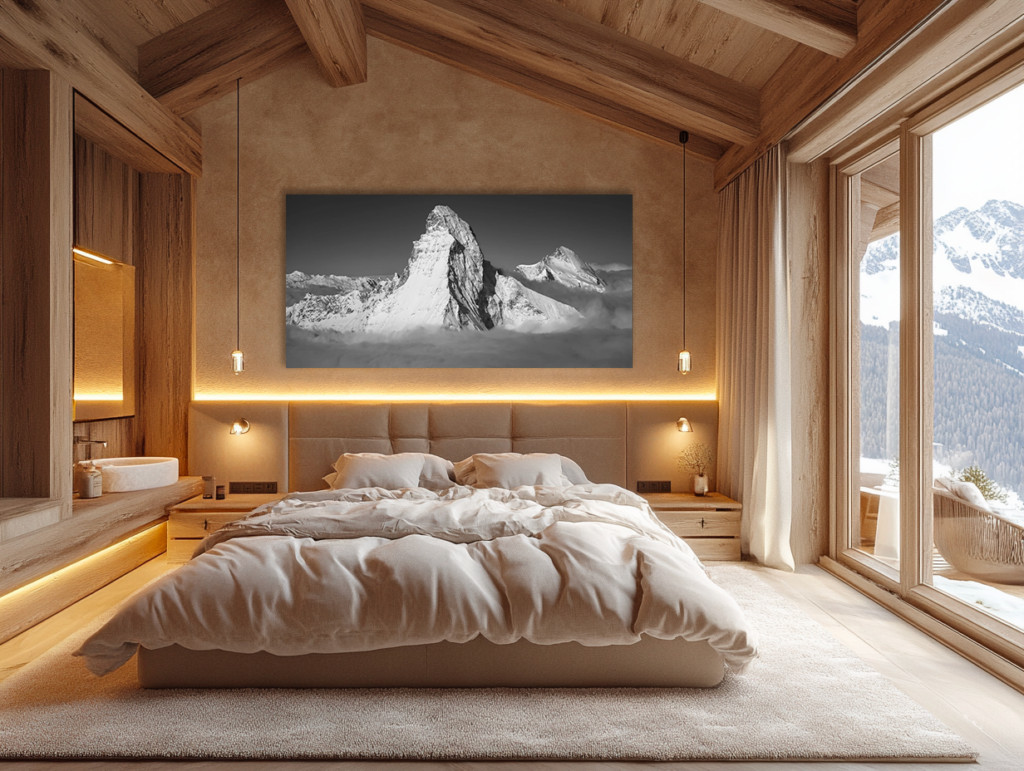
19. Works sensitive to environmental variations
Some artists are now incorporating an evolutionary dimension into their creations, in response to natural cycles. Installations designed to change subtly with the seasons - photosensitive materials, mobile elements that react to humidity or temperature - establish a living link between the work and its alpine context.
A recent creation for a chalet in Crans-Montana features a wall composed of thin strips of wood and metal which, depending on hygrometry, move imperceptibly, modifying the texture and appearance of the whole. This work becomes a sensitive witness to climatic fluctuations, recalling the living, changing nature of the mountain environment.
20. Customized artistic narratives
Perhaps the trend that best sums up the current evolution is that of works conceived as fully personalized visual narratives. These creations incorporate references to the owners' alpine experiences - summits climbed, favorite slopes, favorite places - while maintaining impeccable aesthetic coherence.
A family with a passion for mountaineering recently commissioned a monumental canvas depicting their family's ascent of Mont Blanc, in which each member appears in stylized form, recognizable by a subtle detail, all in a composition that scrupulously respects the actual topography. This work simultaneously celebrates the mountain and the intimate history of those who temporarily inhabit it.
Personalized alpine art: reflecting a new relationship with the summits
Together, these twenty trends paint a portrait of a profoundly changing artistic approach to exceptional alpine residences. Beyond aesthetic considerations, they testify to a renewed relationship with the mountains - more conscious, more personal, more respectful too.
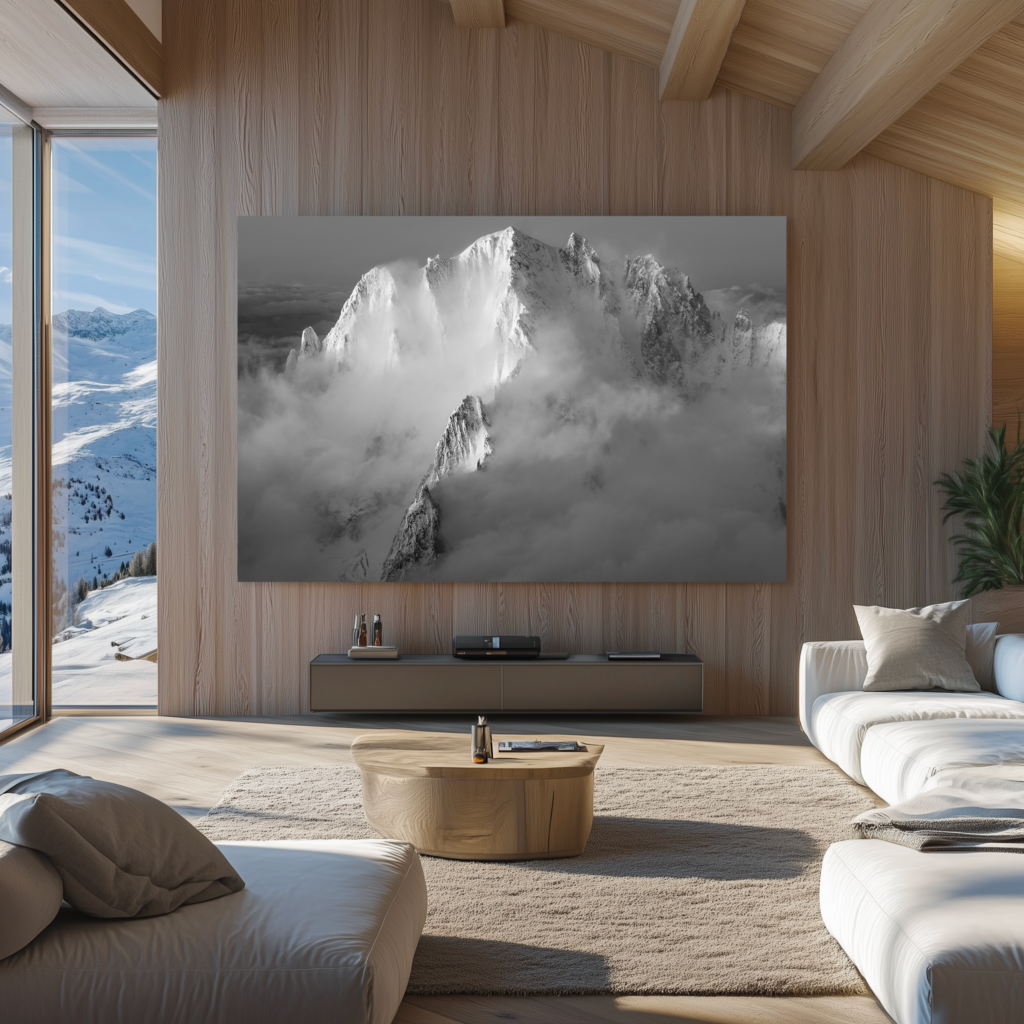
Chalet owners are no longer content to acquire works of art for their decorative or financial value. They are looking for creations that establish an authentic dialogue with the Alpine environment, while reflecting their own sensibility and history. This quest for the perfect match between place, work and inhabitant explains the Previous growth in custom orders.
In 2025, art in mountain chalets celebrates a triple encounter: that of the artist's hand with the raw material, that of tradition with contemporary innovation, and that of the human being with the mountain. These personalized works become the privileged witnesses of an era when authenticity and profound meaning are regaining their rightful place at the very heart of the Alps' most exclusive residences.
